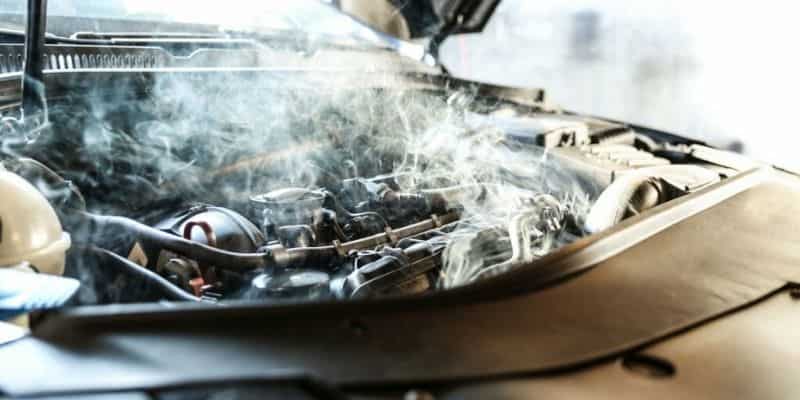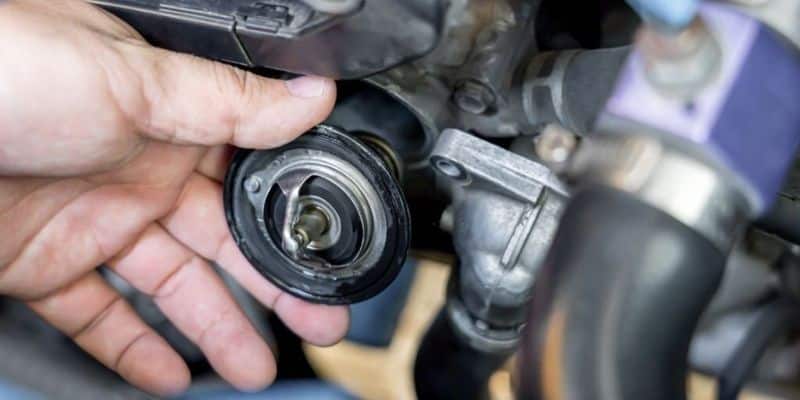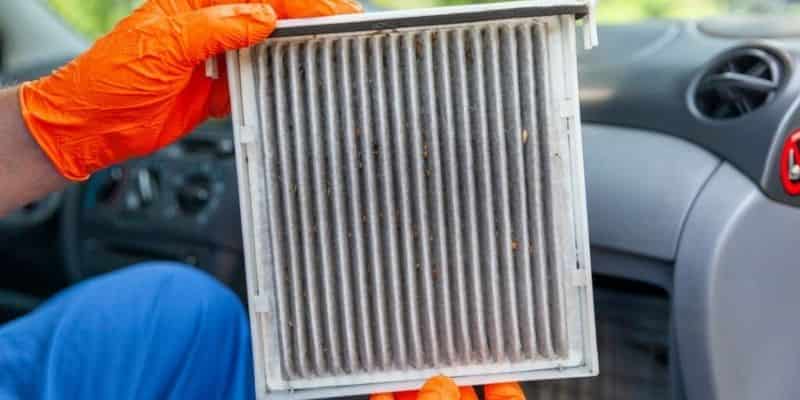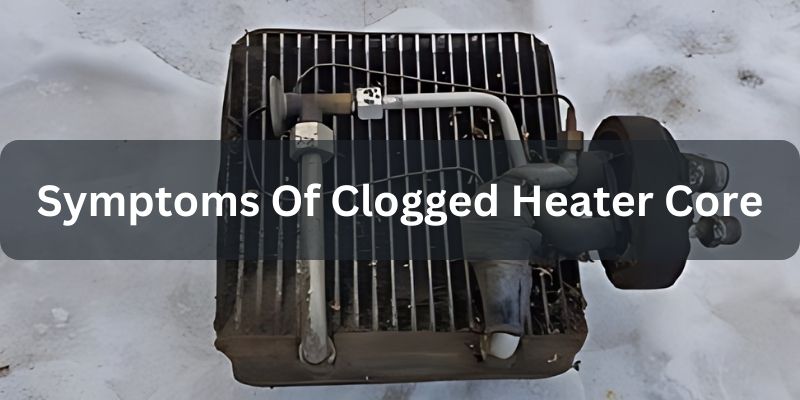The heater core is an often-overlooked component that plays a critical role in maintaining your car’s comfort and overall health. Its primary function is to ensure that warm air circulates through your vehicle’s cabin during cold weather and keeps you cozy while you drive. However, when the heater core becomes clogged, multiple problems can arise that extend beyond mere discomfort.
One of the most noticeable signs of a clogged heater core is reduced heat output, leaving your car chilly even with the heat turned up. You will also notice cold air blowing when the heat is on, and foggy windows can impair your visibility, posing a safety risk. It can lead to engine overheating, potentially resulting in engine failure and coolant leaks that can cause expensive damage.
In this article, we will find out the symptoms of a clogged heater core and its damages and fixes for these potential reasons. Whether you’re a seasoned car enthusiast or a vigilant driver looking to ensure the longevity of your vehicle, understanding these symptoms is crucial for maintaining both comfort and engine health.
Common Symptoms of Bad Heater Core
1. Reduced Heat Output
Experiencing reduced heat output in your car is a clear indicator that something might be wrong with your heater core. When the heater core becomes clogged, it can’t efficiently transfer heat from the engine’s coolant to the interior of your car. This leads to a noticeable drop in the warmth you expect from your vehicle’s heating system.
The actual reason behind reduced heat output is typically a buildup of debris, sediment, or rust within the heater core. This accumulation forms a barrier that hinders the flow of warm coolant through the core, preventing it from adequately heating the air that enters your cabin.
To address this issue, you’ll need to flush the heater core. This involves a thorough cleaning process that removes the obstructions and restores proper heat transfer. Additionally, it’s essential to check your vehicle’s coolant levels and quality. Low or degraded coolant can worsen the problem and may indicate an underlying issue with your vehicle’s cooling system.
2. Cold Air Blowing When Heat is On
When you find cold air blowing from your vehicle’s vents despite having the heat turned on, that’s another sign of a potential problem with your heater core.
The heater core’s primary role is to transfer heat from the engine’s coolant to the cabin, and if the heater core becomes clogged, or obstructed by debris or sediment, it struggles to perform this function effectively. As a result, cold air infiltrates the warm air supply, leaving you in discomfort.
3. Foggy Windows
The heater core plays a pivotal role in regulating humidity inside the car. When it’s clogged, it struggles to maintain this equilibrium, causing condensation on the windows. Foggy windows reduce visibility, especially in cold weather, making it difficult to navigate safely.
Foggy windows in your vehicle aren’t just an inconvenience; they can compromise your safety on the road. When your car’s heater core is clogged, it disrupts the delicate balance of temperature and humidity inside your cabin. This imbalance can lead to moisture accumulating on your windows, resulting in foggy or misty glass.
4. Engine Overheating
Engine overheating is a critical sign of a bad heater core. When the heater core becomes choked, it compromises the circulation of coolant through your engine’s cooling system. This disturbance can lead to a rapid increase in engine temperature, potentially causing severe damage.

When the heater hose is clogged, it restricts the flow of coolant, reducing the system’s overall efficiency. This diminished coolant flow can result in your engine running hotter than it should, leading to overheating of the engine and ultimately car stalling.
Continuing to drive with an overheating engine can lead to permanent damage, such as warped cylinder heads or a cracked engine block. To prevent car overheating, it’s crucial to diagnose the underlying problem of the clogged heater core and correct it accordingly.
5. Coolant Leaks
Coolant leaks are one of the most alarming signs of a clogged heater core. This symptom is a bad sign for the car engine.
The heater core is an integral part of the engine’s cooling system, and when it becomes clogged, it can lead to increased pressure within the system. This elevated pressure can cause hoses and connectors to weaken over time, leading to coolant leaks.
Coolant leaks not only compromise the efficiency of your cooling system but also pose a serious risk to your engine’s health.
Additionally, coolant loss can result in low coolant levels that will ultimately cause overheating, damage to engine components, and, ultimately, costly repairs.
6. Strange Odors
Unusual odors coming from the car vents or car hood can also be a potential sign of heater core problems.
When the heater core becomes clogged, it can create an environment ripe for mold and mildew growth. As air passes through the clogged core, it can pick up these unpleasant odors. These odors are not only unpleasant but also potentially harmful to your health.
Moreover, a clogged heater core can lead to overheating issues in your engine, causing coolant to leak and emit an unusual smell. Recognizing these odors of a clogged heater core is vital, as addressing the issue promptly can prevent further complications.
7. Unusual Noises
A clogged heater core can result in the form of unusual noises within your vehicle. Gurgling or bubbling sounds may emanate from the heater core itself as trapped air and coolant struggle to circulate.
Additionally, a clogged heater core can strain the blower motor, leading to squeaks, rattles, or even a constant humming noise as it works harder to push air through the obstruction.
Understanding these noises as potential signs of a clogged heater core is crucial. Ignoring them can lead to not only discomfort but also potential engine-related problems.
8. Inconsistent Heating
A clogged heater core hose disturbs the even distribution of warm air within your car. When blocks hinder the flow of hot coolant through the core, you may experience fluctuating temperatures, with hot and cold spells within your cabin.
Understanding this inconsistency as a potential sign of a clogged heater core is faulty. It not only affects your comfort but can also indicate an underlying issue with your vehicle’s heating system.
Fixing a Clogged Heater Core
1. Flushing the Heater Core
Flushing the clogged heater core is the most vital and primary step to unclog a heater core.
To flush your heater core effectively, follow these steps:
- Allow the Engine to Cool: Ensure the engine is cool to avoid burns and accidents.
- Locate the Heater Core Lines: Find the inlet and outlet hoses of the heater core.
- Use a Flushing Kit: Connect a flushing kit to these hoses.
- Flush with Water or a Cleaning Solution: Flush the core with water or a specialized cleaning solution to dislodge and remove debris.
- Consider a Reverse Flush: For stubborn blockages, a reverse flush may be necessary.
- Reconnect the Hoses: After thorough flushing, reconnect the hoses.
- Refill with Coolant: Top up the cooling system with fresh coolant.
- Test the Heating System: Ensure the heating system works correctly.

Flushing the heater core effectively restores heat transfer and resolves symptoms associated with a clogged heater core, such as reduced heat, cold air blowing, and inconsistent heating. This maintenance step not only improves comfort but also extends the lifespan of your vehicle’s heating system.
2. Checking Coolant Levels
Addressing a clogged heater core involves more than just flushing; it also requires particular attention to your vehicle’s coolant levels.
Low coolant levels can worsen the heater core issues. When the coolant is insufficient, it disturbs the ability of the heater core to transfer heat effectively, amplifying symptoms like reduced heat output and cold air blowing.
To resolve this, follow these steps:
- Allow the Engine to Cool: Ensure the engine is cool to avoid burns.
- Locate the Coolant Reservoir: Find the coolant reservoir, typically translucent and marked with “coolant.”
- Check Coolant Levels: Observe the level of coolant in the reservoir. It should be between the “minimum” and “maximum” markings.
- Top Up If Necessary: If levels are low, add coolant and distilled water as recommended in your vehicle’s manual.
- Inspect for Leaks: Keep an eye out for any signs of coolant leaks, as these can indicate underlying issues.
Regularly checking and maintaining coolant levels can help ensure the proper functioning of your vehicle’s heating system and prevent further complications related to a clogged heater core. It’s a simple yet crucial step in maintaining your comfort and your vehicle’s overall well-being.
3. Thermostat Replacement
A malfunctioning thermostat can be a reason for heater issues. It regulates the flow of coolant through the engine and the heater core. If the thermostat fails to open or close properly, it can hinder the flow of warm coolant, exacerbating symptoms like reduced heat output and inconsistent heating.
To address this, consider these steps:
- Ensure Safety: Allow the engine to cool down before beginning any work.
- Locate the Thermostat: Find the thermostat housing, often connected to the upper radiator hose.
- Drain Coolant: Carefully drain some coolant to access the thermostat.
- Remove the Old Thermostat: Unscrew and remove the old thermostat.
- Install the New Thermostat: Place the new thermostat in the correct orientation.
- Reassemble: Reattach the thermostat housing, fill the cooling system with fresh coolant, and bleed any air bubbles.
- Test the Heating System: Ensure your heating system now functions correctly.

Thermostat replacement is a strategic step in maintaining your vehicle’s heating system and preventing further complications related to a clogged heater core. By taking this action, you can restore proper heat transfer and enjoy consistent heating in your vehicle.
4. Checking for Blend Door Issues
Blend doors control the mixture of hot and cold air, ensuring you receive the desired temperature inside the cabin. When heater cores clog, it’s not uncommon for blend door issues to emerge, leading to inconsistent heating and discomfort.
To address this, follow these steps:
- Turn the Ignition On: Start the vehicle to access the heating controls.
- Adjust the Temperature: Gradually adjust the temperature from hot to cold and vice versa.
- Listen for Unusual Noises: Pay attention to any unusual clicking, thumping, or grinding noises.
- Feel for Temperature Changes: Confirm whether the air temperature corresponds to your settings.
Blend door issues often appear as noises or a lack of temperature control. If detected, it is necessary to do a thorough inspection by a professional mechanic. They can disassemble the dashboard and access the blend door to diagnose and rectify the problem effectively.
5. Inspecting the Heater Control Valve
When heater cores clog, it can lead to issues with the heater control valve. This valve controls the flow of hot coolant into the core, regulating the temperature of the air that enters inside your car. If it malfunctions or gets stuck, it can result in inconsistent heating and discomfort.
To address this, consider the following steps:
- Safeguard Yourself: Ensure the engine is cool to avoid burns.
- Locate the Heater Control Valve: Identify the valve’s location in your vehicle; it’s typically near the firewall.
- Inspect for Visible Issues: Check for any signs of damage, corrosion, or leaks around the valve.
- Test the Valve: Operate the temperature controls inside your vehicle and observe if the valve opens and closes as it should.
- Check Coolant Flow: Confirm that hot coolant flows into the heater core when you adjust the temperature.
If you suspect issues with the heater control valve, it’s advisable to consult a professional mechanic. They can provide a more detailed inspection and, if necessary, perform any needed repairs or replacements.
6. Cleaning or Replacing the Cabin Air Filter
When heater cores clog, it can lead to air quality issues. Debris and contaminants that accumulate in the core can result in unpleasant odors and diminished air quality. This can affect not only your comfort but also your health.
To remedy this, consider these steps:
- Locate the Cabin Air Filter: Consult your vehicle’s manual to find the filter’s location.
- Inspect the Filter: Examine the filter for dirt, debris, or signs of clogging.
- Clean or Replace: If reusable, clean the filter according to the manufacturer’s instructions. If not, replace it with a new one.
- Regular Maintenance: Consider periodic checks and maintenance to ensure clean and fresh cabin air.

Cleaning or replacing the cabin air filter not only addresses air quality issues but also contributes to a more comfortable and enjoyable driving experience.
7. Heater Core Replacement
A clogged heater core can sometimes reach a point where flushing or repairs are insufficient. If the core is severely damaged or blocked beyond repair, replacement becomes the only viable solution.
To embark on this process:
- Consult a Professional: Heater core replacement is a complex task best left to experienced mechanics.
- Diagnosis: A thorough diagnosis ensures the heater core is indeed the culprit.
- Disassembly: The dashboard and other components may need to be disassembled to access the heater core.
- Replacement: Remove and replace the heater core with a new one.
- Reassembly: Reassemble the vehicle, ensuring all components are back in place.
- Testing: Test the heating system to verify its proper functionality.
However, when facing a severely clogged heater core, it is the ultimate solution to regain efficient heating and maintain your vehicle’s comfort and safety.
8. Hose Inspection and Replacement
Clogged heater cores can place undue strain on hoses. Debris and sediment from the core can accumulate within these hoses, restricting the flow of hot coolant. This can worsen symptoms like reduced heat output and cold air blowing.
To address this, follow these steps:
- Allow Safe Cooling: Ensure the engine is cool before inspection to avoid burns.
- Locate Heater Hoses: Identify the hoses running to and from the heater core.
- Inspect for Damage: Look for signs of wear, cracks, or damage on the hoses.
- Check for Blockages: Ensure the hoses are not clogged with debris or sediment.
- Replace If Necessary: If hoses show signs of damage or blockages, replacement may be required.
Hose inspection and replacement ensure the flow of hot coolant to the heater core.
9. Inspecting the Blower Motor
A clogged heater core can strain the blower motor. As it works harder to push air through the obstructed core, it may start to exhibit symptoms like unusual noises, reduced airflow, or even a complete failure to distribute warm air.
To tackle this issue:
- Ensure Safe Conditions: Always begin with the engine cooled down to avoid accidents.
- Locate the Blower Motor: Identify the blower motor’s position, typically beneath the dashboard on the passenger side.
- Inspect for Damage or Blockages: Check for signs of wear, damage, or debris that may hinder the blower motor’s operation.
- Test Operation: Activate the heating system and observe if the blower motor runs smoothly without unusual noises.
- Replace If Necessary: If you detect severe damage or malfunction, consider replacing the blower motor.
Inspecting the blower motor is crucial for maintaining optimal airflow and heat distribution in your vehicle.
10. Checking for Debris in the HVAC System
Checking for debris within the HVAC system ensures unobstructed airflow and heat distribution. By maintaining a clean and efficient system, you can effectively address clogged heater core symptoms, enhancing cabin comfort and the overall functionality of your vehicle’s heating system.
11. Checking for Airlock in the System
An airlock can disrupt the flow of coolant, exacerbating the core’s obstruction.
To effectively address this issue:
- Engine Cool-Down: Ensure the engine is safely cooled down before proceeding.
- Locate Bleeder Valve: Identify the bleeder valve within the cooling system, usually near the thermostat housing.
- Open the Valve: Carefully open the bleeder valve to release any trapped air within the system.
- Monitor Coolant Flow: Keep an eye on the bleeder valve as you start the engine and ensure a steady flow of coolant.
- Top Up Coolant: If necessary, top up the coolant reservoir to the recommended level.
Checking for airlock in the heating system is vital for restoring proper coolant circulation.
Frequently Asked Questions (FAQs)
What causes a heater core to become clogged?
A heater core becomes clogged primarily due to the accumulation of debris, sediment, and rust within the cooling system. This build-up can result from factors such as inadequate coolant maintenance, the use of low-quality coolant, or a lack of regular system flushing.
Additionally, external contaminants like dirt and dust can find their way into the system, contributing to clogs over time. Proper cooling system maintenance and using high-quality coolant can help prevent heater core clogs.
Can I drive with a clogged heater core?
Driving with a clogged heater core is possible but not advisable. It can lead to reduced heat output, potential engine overheating, and discomfort. It’s recommended to address the issue promptly to prevent further complications and maintain both cabin comfort and engine health.
How much does it cost to repair or replace a heater core?
The cost to repair or replace a heater core varies widely, ranging from $500 to $1,500 or more. Factors impacting the cost include the vehicle make and model, labor rates, and whether you choose to repair or replace the core.
How often should I flush the heater core?
Flushing the heater core is typically recommended as part of regular cooling system maintenance, which occurs every 2 to 5 years, depending on the vehicle and coolant type.
However, it’s essential to consult your vehicle’s manual and follow the manufacturer’s guidelines for specific maintenance intervals.
Conclusion
Recognizing the symptoms of a clogged heater core is vital for maintaining a comfortable and well-functioning vehicle. From reduced heat and cold air blowing to strange odors and unusual noises, these signs signal potential issues within the heating system.
Regular maintenance, including flushing the heater core and inspecting related components, helps prevent costly repairs and ensures a reliable driving experience. Prioritizing these symptoms safeguards both your comfort and your vehicle’s overall performance.

Joseph Morgan has decades of automotive experience. The Detroit native started restoring classics in the 1970s. He owned a vintage repair shop and authored articles for car magazines. With a 1965 Mustang fastback of his own, Joseph now shares advice through his YouTube channel. From engine swaps to rust repair, his expertise helps preserve automotive history.
